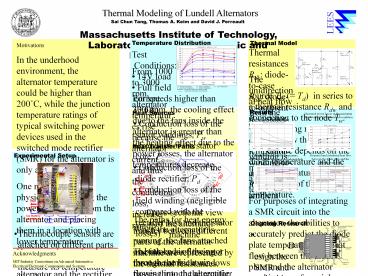One may suggest physically separating the power electronics - PowerPoint PPT Presentation
1 / 1
Title:
One may suggest physically separating the power electronics
Description:
One may suggest physically separating the power electronics from the alternator and placing them in a location with lower temperature. However, ... – PowerPoint PPT presentation
Number of Views:19
Avg rating:3.0/5.0
Title: One may suggest physically separating the power electronics
1
Thermal Modeling of Lundell Alternators
LEES
Sai Chun Tang, Thomas A. Keim and David J.
Perreault Massachusetts Institute of Technology,
Laboratory for Electromagnetic and Electronic
Systems
Temperature Distribution
Thermal Model
Motivations In the underhood environment, the
alternator temperature could be higher than
200C, while the junction temperature ratings of
typical switching power devices used in the
switched mode rectifier (SMR) for the alternator
is only about 175C. One may suggest physically
separating the power electronics from the
alternator and placing them in a location with
lower temperature. However, due to the wiring
between the alternator and the rectifier, this
arrangement can cause EMC problems limit
alternator power greatly increase
manufacturing cost for providing separate
cooling means . Embedding the power electronics
into the alternator can eliminate these drawbacks
but the knowledge of thermal behavior of the
alternator system is essential for the integrated
power unit design. A thermal model for the
alternator is developed to predict the
temperature profile of and heat power flow
between the alternator machine and the embedded
power electronics. From the thermal analysis,
embedding switching power electronics into the
Lundell alternator with low manufacturing cost is
possible by thermally isolating the power
electronics assembly from the alternator machine.
Thermal resistances Rdk diode-to-case Rda
diode-to-ambient Rwk stator-winding-to-case Rwa
stator-winding-to-ambient Rka case-to-ambient
Test Conditions 14V load Full field current
(3.6A)
From 1000 to 3000 rpm, alternator temperatures
rise because the alternator current, and thus the
conduction loss, increase rapidly.
The unidirectional heat flow from the diode
rectifier to the stator winding is modeled by a
dependent temperature
source TD ( Td) in series to a thermal
resistance Rdw and connecting to the node Tw.
This modeling method can describe how the winding
temperature depends on the diode temperature and
the diode temperature is independent of the
winding temperature.
For speeds higher than 3000rpm, the cooling
effect due to the fans inside the alternator is
greater than the heating effect due to the power
losses, the alternator temperatures decrease.
Results
Heat Sources
Measured power losses at the maximum power
transfer (load-matched) condition
Conduction loss of the stator windings, Pw
Iron loss of the stator core, Pc Conduction
loss of the diode rectifier, Pd Conduction loss
of the field winding (negligible compared with
the rectifier loss and the stator losses)
Measured thermal resistances
Heat Transfer Paths
Experimental Setup
Measured and calculated heat flow between the
diode plate and the alternator machine
Measured and calculated temperature distribution
of the alternator at load-matched condition
For purposes of integrating a SMR circuit into
the alternator, the abilities to accurately
predict the diode plate temperature and heat flow
between the diode plate and the alternator
machine are of special importance. The heat power
flowing from the machine to the diode plate is
about 50W which is about 6 of the total stator
losses.
Cross-sectional view of the alternator machine
The paths for heat energy transfer between
different parts of the alternator machine are
represented by the thermal resistances.
Ongoing Research
When the alternator is running, the fans attached
on both ends of the rotor force the ambient air
flowing into the alternator through the two end
windows and out through the side windows (see the
photo). This forced convection cooling removes
the heat generated in the alternator.
Thermocouple sensors are attached on different
parts of the alternator to measure its
temperature distribution. The alternator
operates from 1800 to 6000rpm, which are
corresponding to the engine idle and cruising
speeds.
Design the SMR and embed it into the alternator
working at high temperature. Further increase
Rdk and reduce Rda by thermally isolating the SMR
from the machine and appropriate heatsink deign.
The intake air flowing through the back windows
passes through the rectifier assembly and then
through part of the stator winding. This
unidirectional airflow results in a
unidirectional heat transfer path from the
rectifier to the stator winding, and this kind of
heat transfer cannot be simply represented by a
thermal resistance.
Acknowledgments MIT/Industry Consortium on
Advanced Automotive Electrical/Electronic
Components and Systems

